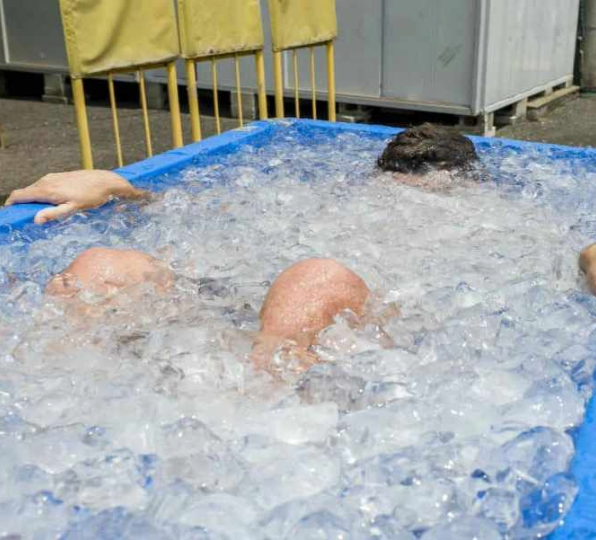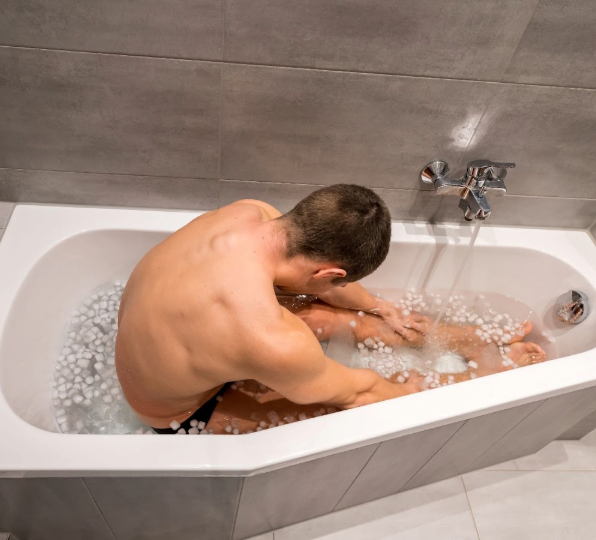Introduction:
As a recovery and performance-enhancing tool, ice baths—also referred to as cold water therapy or cold immersion therapy—have grown in popularity among athletes, fitness enthusiasts, and health-conscious people. Although proponents list many advantages, such as improved circulation and a reduction in muscle soreness, there are possible hazards and things to be aware of. We’ll examine the advantages and disadvantages of ice baths in this post, along with the best ways to use them in a secure and efficient manner.
The advantages of ice baths:
1. Reduced Muscle Soreness
Reduced muscle soreness is a desirable outcome for anyone engaging in physical activity, particularly those who are new to exercise, increasing their workout intensity, or participating in activities that target specific muscle groups. Muscle soreness, also known as delayed onset muscle soreness (DOMS), typically occurs 24 to 72 hours after strenuous exercise and is characterized by stiffness, tenderness, and reduced range of motion in the affected muscles. While muscle soreness is a natural response to exercise-induced muscle damage and is often a sign of muscle adaptation and growth, excessive or prolonged soreness can impede recovery and detract from the overall exercise experience.
2. Enhanced Recovery
One of the primary mechanisms through which ice baths facilitate recovery is by reducing inflammation and swelling in the muscles. Intense exercise leads to microtrauma and inflammation in muscle fibers, resulting in soreness and stiffness. The cold water in an ice bath constricts blood vessels and decreases blood flow to the muscles, which helps limit the inflammatory response and reduce swelling. This vasoconstriction also helps flush out metabolic waste products such as lactic acid, which can accumulate during intense exercise and contribute to muscle fatigue and soreness.
In addition to reducing inflammation and swelling, ice baths help restore muscle function and alleviate muscle soreness. The cold temperature numbs the nerve endings in the muscles, providing temporary pain relief and allowing athletes to recover more quickly. Ice baths also facilitate the constriction of blood vessels, which helps prevent further tissue damage and speeds up the repair process. As a result, athletes who incorporate ice baths into their recovery routine often experience reduced muscle soreness, improved range of motion, and faster recovery between training sessions.
Furthermore, ice baths may have a positive impact on the central nervous system, helping to regulate the body’s stress response and promote relaxation. The intense cold triggers the release of endorphins, which are natural pain relievers and mood enhancers. This can help athletes feel more relaxed and mentally refreshed after an ice bath, allowing them to recover both physically and mentally.
While ice baths can be an effective recovery tool, it’s essential to use them judiciously and in conjunction with other recovery strategies. Some athletes may find ice baths uncomfortable or intolerable, and they may not be suitable for individuals with certain medical conditions or injuries. It’s also crucial to allow time for the body to warm up gradually after an ice bath to prevent cold-related injuries.
3.Improved Circulation
Cold water immersion, often referred to as cold therapy or cryotherapy, is known to have profound effects on circulation and blood flow, particularly when used as a recovery tool after intense physical activity or injury. When the body is exposed to cold temperatures, such as those encountered during cold water immersion, it triggers a series of physiological responses aimed at maintaining core body temperature and ensuring adequate blood flow to vital organs and tissues.
One of the primary effects of cold water immersion on circulation is vasoconstriction, the narrowing of blood vessels in response to cold stimuli. When the body is exposed to cold water, blood vessels near the skin’s surface constrict in an effort to conserve heat and prevent heat loss. This vasoconstriction helps redirect blood flow away from the extremities and towards the body’s core, where vital organs such as the heart, lungs, and brain are located.
Following vasoconstriction, cold water immersion also induces vasodilation, the widening of blood vessels, which occurs as the body adjusts to the cold stimulus. Once the initial shock of cold water immersion subsides, blood vessels begin to dilate, allowing blood to flow more freely to the muscles and extremities. This vasodilation helps improve circulation and increases blood flow to areas that may have experienced reduced blood flow during vasoconstriction.
The alternating effects of vasoconstriction and vasodilation induced by cold water immersion promote what is known as the “cold-induced vasodilation” response. This phenomenon leads to improved circulation and blood flow to the muscles and extremities, facilitating the delivery of oxygen and nutrients to the tissues while aiding in the removal of metabolic waste products such as lactic acid.
4.Pain Relief
Ice baths, also known as cold water immersion therapy, are widely recognized for their analgesic properties and their ability to provide temporary relief from pain associated with acute injuries, soreness, or inflammation. This therapeutic technique involves immersing the body, typically up to the waist or shoulders, in cold water for a predetermined duration, typically around 10 to 15 minutes. The cold temperature of the water induces a numbing effect on pain receptors, providing immediate relief and promoting recovery.
One of the primary mechanisms through which ice baths alleviate pain is by temporarily blocking pain signals from reaching the brain. When the body is exposed to cold temperatures, nerve endings in the skin and underlying tissues become less sensitive to pain stimuli. This desensitization occurs due to the activation of cold receptors, which inhibit the transmission of pain signals along nerve pathways. As a result, individuals experience a reduction in pain perception, allowing them to tolerate discomfort more effectively and engage in activities that may otherwise be painful.
Ice baths also help reduce inflammation, swelling, and tissue damage associated with acute injuries, which can contribute to pain relief. The cold temperature constricts blood vessels and reduces blood flow to the affected area, limiting the inflammatory response and preventing excessive swelling. Additionally, the vasoconstrictive effects of cold water immersion help numb nerve endings and reduce the production of inflammatory mediators, such as prostaglandins and cytokines, which can contribute to pain and discomfort.
5.Enhanced Mental Well-Being
Cold water immersion, often referred to as cold therapy or cryotherapy, has emerged as a promising technique for enhancing mental well-being and promoting overall mood and emotional health. This therapeutic practice involves immersing the body in cold water for a predetermined duration, typically ranging from a few minutes to up to 15 minutes. While the idea of submerging oneself in icy water may seem daunting, the benefits for mental health are profound and well-supported by research.
One of the primary mechanisms through which cold water immersion enhances mental well-being is by stimulating the release of endorphins, neurotransmitters known as the body’s natural painkillers and mood enhancers. When the body is exposed to cold temperatures, such as those encountered during cold water immersion, it triggers a cascade of physiological responses aimed at maintaining core body temperature and ensuring survival. One of these responses involves the release of endorphins, which help modulate pain perception, reduce stress, and promote feelings of relaxation and euphoria.
The release of endorphins during cold water immersion can have a powerful impact on mental health, leading to reduced stress, anxiety, and depression, while promoting an overall sense of well-being and emotional balance. Endorphins act on the body’s opioid receptors, producing feelings of pleasure and reward similar to those experienced after engaging in physical exercise or other pleasurable activities. This natural “high” can help individuals cope with stress more effectively, improve mood, and enhance resilience in the face of life’s challenges.
Risks and Considerations:
- Risk of Hypothermia: Exposure to cold water for extended periods can increase the risk of hypothermia, a potentially life-threatening condition characterized by abnormally low body temperature. It’s essential to monitor the duration and temperature of ice baths carefully and avoid prolonged exposure, especially in individuals with reduced cold tolerance.
- Impaired Recovery: While ice baths can be effective for short-term pain relief and recovery, prolonged or excessive use may impair long-term recovery and adaptation. Some research suggests that cold exposure may interfere with the body’s natural inflammatory response, which plays a crucial role in tissue repair and adaptation to exercise.
- Decreased Muscle Adaptation: Cold water immersion may inhibit muscle adaptation and hypertrophy by blunting the inflammatory response and reducing the activation of satellite cells, which are involved in muscle repair and growth. This could potentially hinder long-term gains in strength and muscle mass, particularly when used excessively.
- Skin Damage: Prolonged exposure to cold water can cause skin damage, including frostbite, numbness, and tissue necrosis. It’s essential to protect sensitive areas of the body, such as the fingers, toes, and ears, from prolonged exposure to cold water and monitor for signs of frostbite or skin irritation.
- Contraindications: Ice baths may not be suitable for everyone, especially individuals with certain medical conditions or health concerns. People with cardiovascular problems, Raynaud’s disease, or cold intolerance should consult with a healthcare professional before attempting cold water therapy.


Conclusion:
Ice baths can be a valuable tool for reducing muscle soreness, enhancing recovery, and improving performance, particularly for athletes and active individuals. However, it’s essential to weigh the potential benefits against the risks and considerations and approach cold water therapy with caution. By following best practices, monitoring exposure carefully, and listening to your body, you can safely incorporate ice baths into your recovery routine and enjoy the benefits of cold water therapy without compromising your health and well-being.












